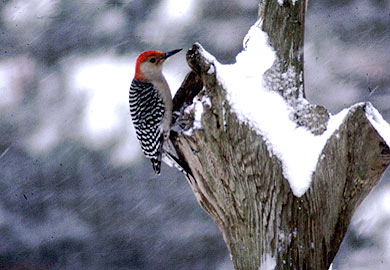DNR News
** Archived Article - please check for current information. **
December 23, 2014Many animal species benefit from snags, so leave some standing dead trees
Standing dead trees, or snags, may appear to be useless, even eyesores, but a state wildlife biologist says actually they are important components of wildlife habitat and frequently in short supply.
"That snag may provide a secure home for many kinds of animals and a virtual smorgasbord of insect food," said Johnny Stowe, wildlife biologist, forester and heritage preserve manager with the S.C. Department of Natural Resources (DNR). "Downy, hairy, red-bellied, pileated and red-headed woodpeckers all feed heavily on wood-boring larvae of beetles and other insects and invertebrates found in snags."
To view or print out a wildlife management guide on snags and downed logs, visit the DNR website or call the Columbia DNR office at (803) 734-3886.
“Snags that are near homes or other structures may need to be removed for safety reasons,” Stowe said, “but when they are not hazardous ‘backyard’ snags, or one near a deer stand, they may provide wonderful wildlife viewing opportunities.”
Woodpeckers are also the primary excavators of nesting cavities in snags, Stowe said. These cavities are later used by other species. Bluebirds, wood ducks, titmice, great-crested flycatchers, chickadees, nuthatches, barred owls, screech owls and kestrels all depend on cavities for successful nesting.
“In North America, snags provide habitat for at least 85 bird species that nest in tree cavities,” Stowe said. “Cavities in snags are a critical resource for many species, and cavity-nesting birds can comprise up to 40 percent of the bird community within some forests.”
Mammals such as bats, gray squirrels, fox squirrels, flying squirrels and raccoons also use cavities in snag trees. Tree cavities are also used by frogs, snakes, honeybees, wasps, spiders and aquatic invertebrates. A single snag tree may contain many cavities useful to a multitude of species, as well as providing a food supply.
"The value of snags to both wildlife and people are countless," Stowe said. "Many snag-dependent species control insects and pests, and birds of prey prefer the vantage point snags afford for hunting rodents. The woodpecker's diet is filled with many insects that can be harmful to our interests."
There are two kinds of snags, according to Stowe. A "hard" snag may be only partially dead, with many limbs remaining and sound wood. This kind of snag will be beneficial for many years. A "soft" snag is more decayed, with no limbs left and advanced heart rot. Wildlife species make use of both kinds of snags, but larger snags have more value.
In woodlots, at least four to five snags per acre should be maintained, according to Stowe. Snags left in open areas over water will also provide hunting perches for flycatchers, bluebirds, hawks and kingfishers. Osprey may nest in large snags near open water.
"Snags may not appear very attractive, but their value to wildlife is clear," said Stowe. "Wildlife enthusiasts should take a second look at dead or dying trees on their property and include snags in their wildlife management or landscaping plans."
More News
- Spartanburg man receives Fire Bird Conservation Award for dedication to bobwhite quail
- Prescribed burns restore habitat, improve safety on heritage preserves
- Here are some simple ways for people to help wildlife during holidays
- After the holidays, let Christmas trees benefit fish and wildlife
- Many animal species benefit from snags, so leave some standing dead trees
- Milton Reisen honored as Certified DNR Fishing Instructor of the Year
- Fort Frederick Heritage Preserve Friday tours from Jan. 16-Feb. 6
- DNR awards scholarships for youth skeet, trap event
- Trout stocked by helicopter on the Lower Saluda
- DNR stocks red drum at Cherry Grove
- South Carolina Quail Council advocates for habitat restoration
- Freshwater fishing trends
- Saltwater fishing trends
- S.C. weekly tidetable
- DNR video
- Archived news releases
